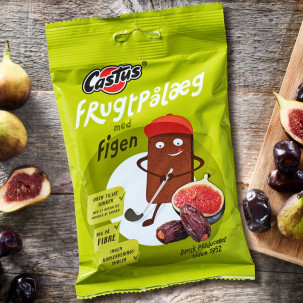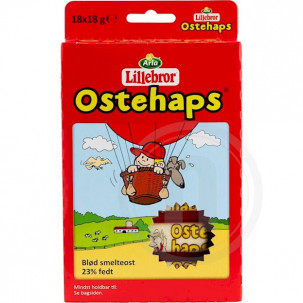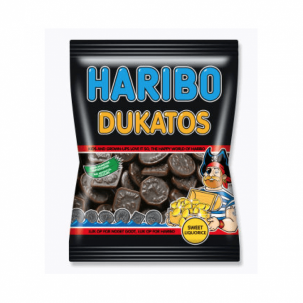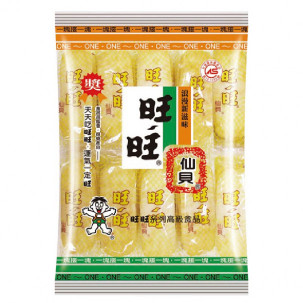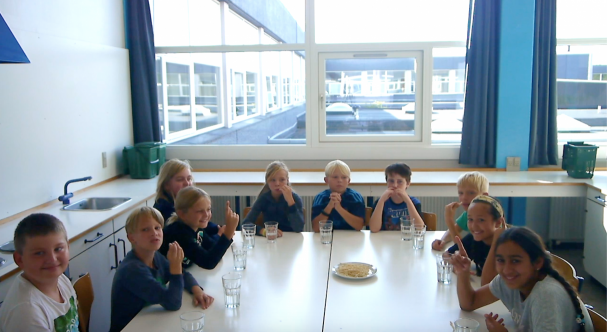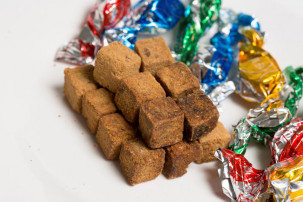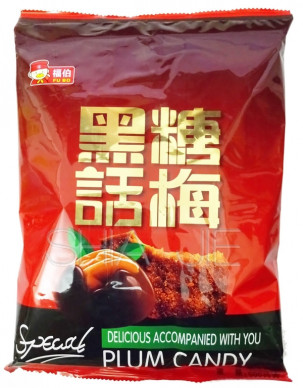Even though now I could very proudly say, “I like licorice, especially the salty one!”, I still remember the first time trying liquorices, completely misunderstanding it as chocolate, I spit it out right away.
As a Taiwanese, I have to say I have never tried anything like licorice before. Even though we do use licorice root in our culture, and some of my friends normally linked it with star anise. It was still something new and bizarre for me.
Ever since, my shocking experience of licorice has been the connection between me and other foreign friends, and a perfect icebreaker when I first met a Dane. Normally, they would show their understanding but cannot help but say ''The salty one is the best !'' As far as I know, most of them love licorice from their childhood, however, it is never a surprise for them to see a more exaggerating reaction toward licorice.
On the other hand, I started to think about all the “normal” snacks as a person like for me grown up in Taiwan, are they actually something bizarre for Danish kids?
Therefore, I decided to have a snack/candy tasting, in both Denmark and Taiwan. The setting was that Danish kids would have to taste several common Taiwanese snacks/candies and their reaction and description would be noted down by me, and vise versa.
The snacks/candies I eventually chose:
5 Danish snacks/candies:
- Castus date-based bar
- Snack salami
- Ostehaps snack cheese
- Haribo sweet licorice (Dukatos)
- Haribo salty licorice (Super Piratos)
(All these choices were suggested by my local Danish friends).
6 Taiwanese snacks/candies:
- Rice cracker
- Tuna tidbit candy
- Roasted crispy seaweed
- Semi-dried shredded squid
- Dried fish surimi
- Salty plum candy (salted plum covered with hard toffee)
I had a bit more focus on fishy products since I was working on a squid project before and would like to know of these types of snacks could have some potential in Denmark.
The background of the selected kids:
Taiwan:
The tasting was conducted in Tsinghua after-school in Taipei, on 2 different age group of kids: 2nd-grade (8-year-old) and 6th-grade (12-year-old).
Denmark:
The tasting was conducted in Brøndbyøster Skole in Brøndby. All the kids were from 3rd-grade, aged 8-9.
Castus
Castus fruit bar is made from mostly dates and figs, and has had a long history in Denmark. The highly acceptability, convenience and relatively healthy natures win parents preference, which results in Castus fruit bar has become one of the regulars in lunch boxes of Danish children.
How Taiwanese kids think about Castus
The 2nd-grade kids mistook the fruit bar as chocolate at the first sight, but quickly denied their own thoughts from the sour smell. Some children linked the acidic smell to salted sour plum, which is a kind of traditional candy in Taiwan, and will be mentioned in the following texts. Most of the 2nd-grade kids did not appreciate the sour taste, but 4 out of 17 liked it because of their personal preference for sourness.
Even though I did not mention even a hint of what they were eating, some of the kids could still recognize the bar was made from crushed fruit, among them, one said it was similar to berries. It is noteworthy that figs and dates were not common in Taiwan, not to mention their derivatives. Compared to the 2nd-grade, the 6th-grade kids were obviously able to put more words on describing texture. Interestingly, for children who liked Castus, it was not only the sweetness that fascinated them, but also the brittle texture. However, some still thought it was too sour to their taste. A few of them expressed the its similarity with raisins, longans or cranberries.
Arla Lillebror Ostehaps®
Arla Lillebror Ostehaps® was first launched in 1986. It is a soft type of processed cheese, which is mostly marketed for children because of its mild and childfriendly flavors and is well used in packed lunches in primary schools. Data says there were 40 millions of Ostehaps® sold in Denmark every year.
How Taiwanese kids think about Ostehaps
Taiwanese kids had no difficulties recognizing that it was cheese. I remember that cheese was not a common thing that my parents would provide me when I was little. However, nowadays cheese variety increases on supermarket racks and more people start to incorporate it into their normal diet. Even though the most common types are still processed cheese, in cubes, triangles or slices. I was actually wondering if Taiwanese kids would be able to recognize non-processed cheese as cheese as well?
The majority of 2th-grade kids loved cheese snacks, however, there were two addressing that they didn’t appreciate flavors of cheese, which according to what they said, was stinky. A girl from the 6th grade mentioned that she only liked melted cheese, if not, then she found it disgusting. To be honest, my mom also mentioned the same thing to me, it seems like since we do not have cheese culture rooted, cheese that has been melted is the most common, therefore the most accepted form of cheese.
Salami snack
How Taiwanese kids think about Salami snack
The third tasting was salami snack. This product was not that unfamiliar for Taiwanese kids since we also have salami and sausage in Taiwan, not as snacks though. The most interesting thing was that even though the 2nd-grade kids described the flavors as hard, salty, sour and greasy, they still showed astonishing likeness to the salami snack. However, the taste preference seemed a bit different in between the 2nd- and the 6th-grade kids. There was a higher proportion of 6-grade kids being unappreciative of the snack salami since they thought it was way too hard and salty.
Licorice
In most of the licorice candies, the licorice taste is enhanced by aniseed oil, and the actual content of licorice is rather low. Licorice confections are primarily popular in several European countries, such as Netherlands and notably, Nordic countries. There are two main different kinds of licorice: sweet and salty. The salty one is mixed with ammonium chloride (salmiak) and only a few have common salt (Sodium Chloride) in their ingredients. Ammonuum choloride (Salmiak) was once used as cough medicine in history, however, there is no clear evidence that we could trace back when and why people start to combine salmiak and licorice together. But it is known that the salty licorice has been produced in Nordic countries and Netherlands since the 1930s and become widely-popular since then.
How Taiwanese kids think about licorice
Again, they misunderstood the licorice as chocolate for the the appearance, but soon realize it was not according the the different smell and texture by touching. Interestingly, some kids expressed that it smelt like Chinese medicine, which was actually quite reasonable. In Chinese Medicine, star anises and licorice are two very common ingredients, and are widely applicable. After tasting, everyone frowned and yelled out their inappreciativeness. The bitterness shocked them. Some considered it tasted so much alike star anise, but there was also a girl asked me if it was coffee candy. However, they all agreed that it was “a really strange candy”. After I explained the candy was made from licorice, a few kids spit it right away. Following the sweet licorice, only few took the salty licorice. Unsurprisingly, none of the kids found the flavor of salty licorice bearable.
The feedback from the 6-grade kids gave more information again on the texture: they mentioned both the types of licorice were hard and sticky. On the taste-wise, besides the similarity of tasting like Chinese medicine, or star anise, a girl shrieked and repeated saying that the salty licorice was very spicy.
On The Other Side
Taiwan is an island in the midst of Pacific Ocean, influenced a lot on food culture from surrounding countries, as well as American and European eating habits. However, thanks to the geographical factors, there are a variety of seafood-related things, including commercial snacks, that I could prepare for the Danish kids to try. This time, I chose 6 different items, which were: seaweed chips, rice cracker, tuna candy, fish surimi, shredded squid, and candied salty plum.
Rice crackers
Taiwan is located in the main rice producing areas of Asia, therefore, rice is undoubtly the most important source of staple food. Moreover, thanks to the diversity of ethnic groups Taiwan has, rice is also used to make a variety of different derivatives. Rice cracker is absolutely the most common form of rice as a snack. Rice is milled, removed excess water, seasoned and baked. After the baking process, a puffed and porous structure is created, which gives a crunchy texture. The seasonings used are sugar, glucose, powdered soy sauce, salt and MSG.
How Danish kids think about rice crackers
Surprisingly, every 2nd-grade kid loved the cracker. They liked the taste of the seasoning powder and the crispy texture. A kid said that it tasted like waffles but multiplied 100 times(I assume it was something really good). A few kids thought it tasted similar to breakfast cereal. Some pointed out it was like prawn crackers: flavorful outside but plain inside.
Seaweed chips
Seaweed chips are a common snack in Taiwan, which were originated from the unseasoned-roasted seaweed for sushi wrapping for more than 40 years ago. Nowadays, there are a lot of different varieties of seasoned seaweed chips, together with imported versions from Japan, Korea or even Thailand in Taiwanese supermarkets. These seaweed chips are quite versatile on the way of being consumed. They could be eaten just as snacks, or could be a kind of side dish used for wrapping rice to encourage children to eat more. They could also be used in soup or being shredded as garnish for dishes. The seaweed chips I got this time were mainly seasoned with sugar, soy sauce, salt, Shitake mushroom extract, Kombu and mirin.
How Danish kids think about seaweed chips
The kids loved the color of the seaweed chip, however, the taste was not what everyone welcomed. Half of the kids liked the seaweed chips, yet the other half of them mentioned it tasted too much like sea and fish. There was also a kid said even though it was not spicy, but he sensed a chili taste in it.
Surimi snack
The surimi snack in Taiwan has had more than 40 years of history. The surimi snack is made from frozen fish batter, which then was seasoned, shaped, roasted and shredded. Due to the fact that Taiwan is an island with abundant of fish sources, in order to reuse the lower quality of fish which was normally abandoned or threw back to the ocean, people started to transform the wasted produces to something more valuable, which was the beginning of the surimi snack.
How Danish kids think about surimi snack
One of the kids said it tasted a lot like sushi and a few said they tasted chili. In general, the flavor was described fishy and seemed to be a bit too strong for some of the kids. The texture was characterized gummy and paper-like. Surprisingly, a few kids showed their liking and even took a second piece.
Tuna candy
The tuna candy was made from fish flesh, mixed with seasonings such as soy sauce, salt, sugar and a bit acids which was barely noticeable. The mixture then was roasted, dried and cut into cubes. The colorful candy wrapper is especially the part that makes everyone in Taiwan could easily recognize it.
How Danish kids think about tuna candy
Children expressed that it was a brand new taste, which tasted fishy but also a bit sweet and spicy. Some asked if there was chili inside. The texture, according to description, was hard so that some kids even linked it with dog food. Obviously, they were not a huge fan of the candy, but found it was acceptably okay.
Semi-dried squid
The semi-dried squid is made from fresh squid, which was marinated, dried, pressed, roasted and shredded.
How Danish kids think about semi-dried squid
The thing that has been noticed was that almost every kid took a sip of water after eating it. They expressed that it tasted sour and sweet. On the other hand, the texture was described as hard and gummy. Noticeably, on the moment of hearing the snack was made from squids (blæksprutter), the kids looked shocked. Squid was apparently something they were seldom exposed to, which was similar to the result we found out through our previous investigation on the squid event.
Caramel candy with preserved salted plum center
The techniques for fruit drying has been rooted since Han dynasty of China for more than 2200 years ago. Taiwan inherited the techniques, combined together with the nature that keep providing enormous amount of fruit all-year-round, salted-dried fruit has become one of the most common fruit preserves in Taiwan. Salted-dried plum is especially common, consumed as snacks, or used in tea and dishes. This caramel candy has a very rich caramel on the outside but a preserved salted plum at the center, which prohibits eaters to bite or chew but should suck the candy and get both the sweet, salty and sour taste at the same time.
How Danish kids think about candy with salted plum
The kids expressed that the taste was a mixture of caramel and chili, together with some describing it as smoky and some described it as licorice. Most of the kids only appreciated the caramel part but not the plum, it seemed too sour for their taste.
To sum up...
It is really hard to say that if it was more weird for Taiwanese children to try the Danish snacks or vise versa. But It was not surprising that the snacks I chose for each side were never tasted by the other side before, but the kids did try to make association with something they are more familiar with, regarding appearance, taste and texture.
Last but not least...
During the tasting, I noticed some Danish kids saying that they never ate fish, only sushi. However, when they were asked if they have ever tried salmon, then the answer was an obvious YES. I personally concluded that they probably didn’t consider “laks” (salmon) as “fish”.
Mentioned in the article
Yi-Ting Sun is a research assistant at Nordic Food Lab, where she works with taste and texture of Danish ten-armed squids in the so-called "Squid squad". Yi-Ting Sun is from Taiwan.

